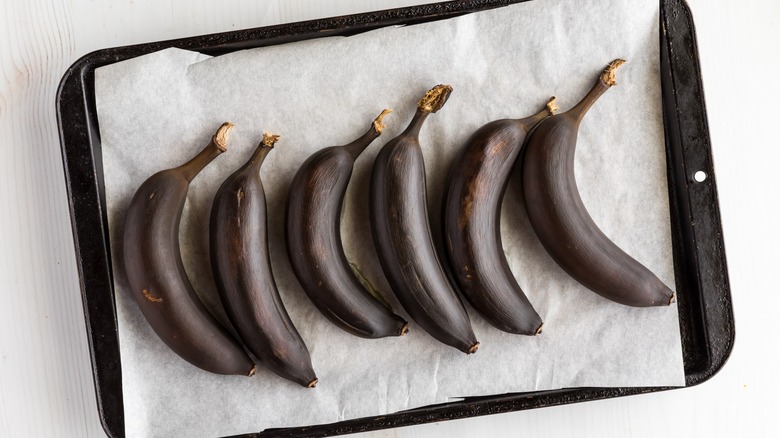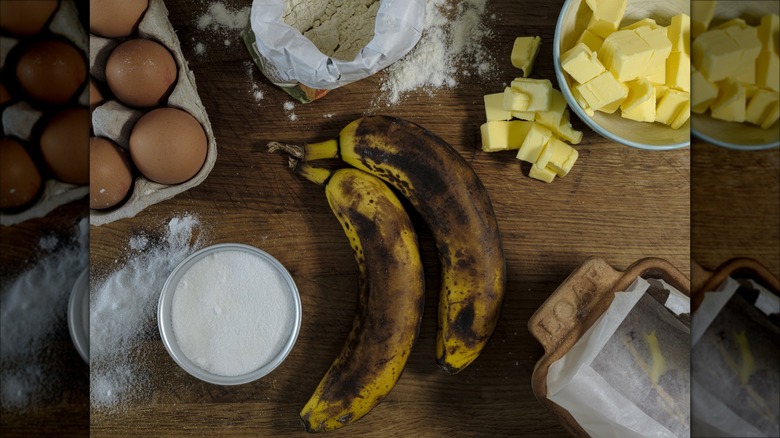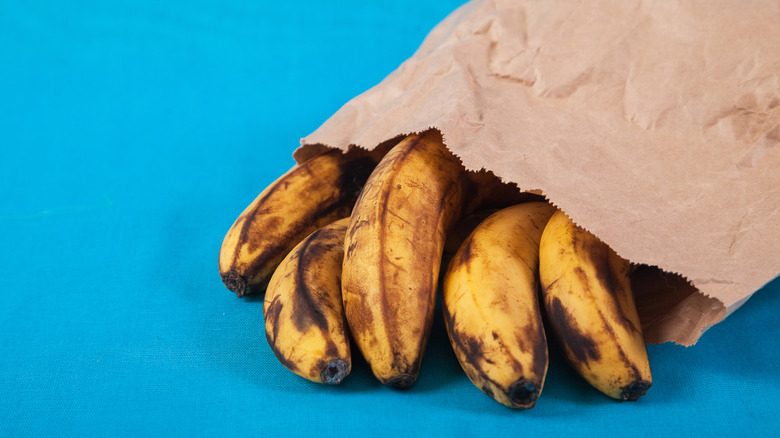Your Oven Is The Key To Ripening Bananas In A Flash
When shopping for bananas, the running assumption is usually that they're not today's bananas, but next week's. The selection at the grocery store is often limited to 'naners that are tinged with green and nowhere ready to be mashed into banana bread or eaten as a snack. When you really need bananas, but all you have are green ones, you have a handful of options. You could eat them slightly unripened (yuck), sit around and stare at them until they ripen (no thanks), throw them in a paper bag, or toss them in the oven. Since the first two options aren't ideal, we'll focus on the latter two, which work quite nicely, thanks to science.
To understand why paper bags and oven ripening work so well, you'll need to know some biochemistry. Don't panic though — the science of ripening is fairly straightforward. Under normal circumstances, ripening occurs when a fruit undergoes a series of chemical changes, transforming it from hard, fibrous, and starchy into something soft, sweet, and aromatic. As part of this process, ethylene gas is produced, speeding up the ripening process. At the same time, enzymes in the fruit break down large starch molecules into sugars and weaken the fruit's cell walls. Unripe fruit tends to be green due to the presence of the plant pigment chlorophyll, which also degrades during ripening, revealing the distinctive color that fruit gets from other plant pigments.
The oven method for ripe bananas
The quickest method for ripening bananas involves your oven and an hour or less of your time. To try it, line a baking sheet with parchment paper to catch any stickiness that might escape during baking, and bake at 300 degrees Fahrenheit until the bananas are softened to your liking. Don't be alarmed if the bananas come out blackened and squishy, though these aren't the ones you'll want to shove into a lunchbox. Rather, use this hack when you need a mashed or very soft banana, like for muffins, pancakes, banana ice cream, bananas foster, or overnight oats. Plus, there are a variety of uses for the peels, even if they're mushy.
Going back to our biochemistry lesson, there's some science behind why this works. Here, heat acts as the main catalyst, speeding up some of the chemical reactions of ripening, including starch-to-sugar conversion, cell wall weakening, and chlorophyll breakdown.
If you have more time, try a paper bag
If you don't urgently need a ripe banana, but you'd like to have it within a day or so, opt for the paper bag method. Simply place your bananas in a paper bag, fold down the top, and wait a day or so for them to ripen. To speed up the process and ripen your bananas overnight, place a fruit like a pear, avocado, apple, peach, plum, or mango in the bag as well. These are known as climacteric fruits, which keep ripening after they're picked, producing ethylene gas.
It is worth noting that bananas need to breathe a bit here, as oxygen is needed to make the chemical reactions of ripening happen. This is how the paper bag works — it's porous enough to allow oxygen in but can trap enough ethylene gas to effect the reaction. This works in reverse to keep bananas from overripening while storing them in the fridge or pantry — you want to prevent the bananas from being in close quarters with other ethylene producers. Plus, when bananas are sealed in an airtight container or vacuum-sealed by themselves, ripening slows drastically due to the lack of oxygen. This all goes to show that cooking is not just an art, it's a science too.


